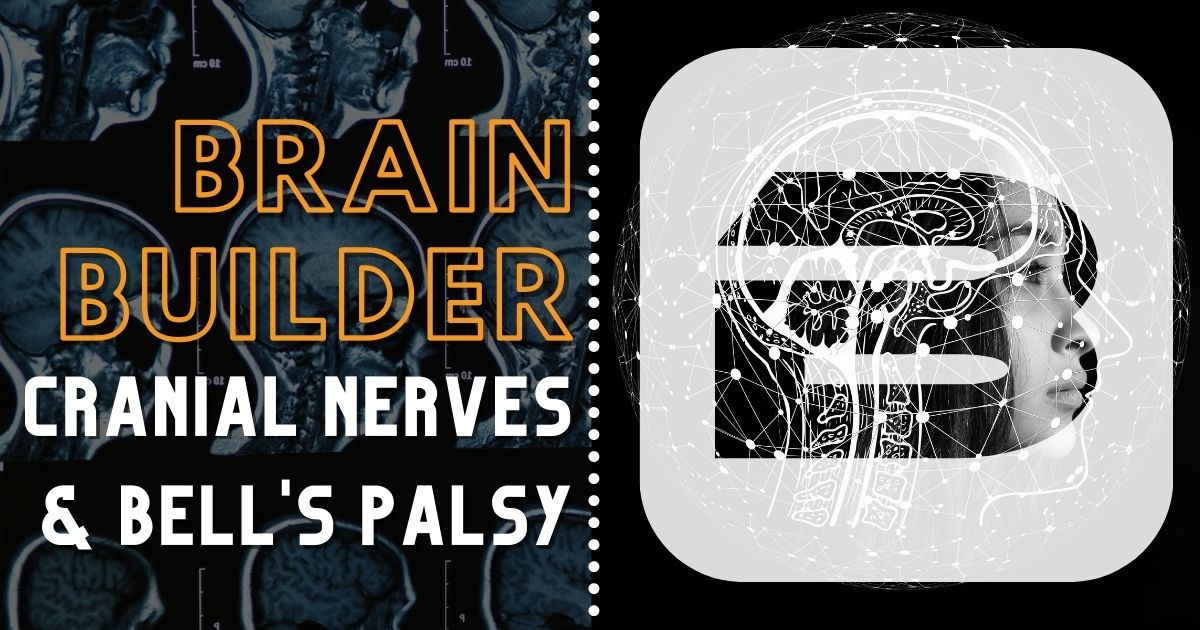Cranial Nerves and Bell’s Palsy
by Robert Tallitsch, PhD | September 15, 2022

Free video explaining the 12 pairs of Cranial Nerves and Bell's Palsy. Use this video and article in your anatomy class!
Schedule a demo to learn about BodyViz interactive activities, virtual dissection, real patient case studies, and other resources to incorporate into your classes!
Schedule a Demo
Written by: Robert Tallitsch, PhD
Idiopathic facial palsy, also known as Bell’s Palsy, is a form of temporary facial paralysis or weakness on one side of the face, resulting from a dysfunction of the VIIth cranial nerve. Bell’s Palsy affects approximately 40,000 people in the United States yearly, and an unknown number of individuals internationally. This Brain Builder will briefly discuss the twelve cranial nerves, with particular attention to the VIIth cranial nerve. We will then discuss the symptoms, diagnosis, and treatment of Bell’s Palsy.
Cranial Nerves of the Brain
Twelve pairs of cranial nerves are visible on the ventrolateral surface of the brain. These twelve pairs of cranial nerves exit the brain and leave through fissures and foramina of the skull. Contrary to spinal nerves, which are numbered by Arabic numerals as one moves along the spinal cord superiorly to inferiorly, the cranial nerves are numbered by Roman numerals as one progresses rostrally to caudally along ventral surface of the brain.
With the exception of the Xth cranial nerve, which supplies structures within the thorax and abdomen, all of the cranial nerves are distributed to structures within the head and/or neck.
The twelve pairs of cranial nerves are named as follows:
I. Olfactory
II. Optic
III. Oculomotor
IV. Trochlear
V. Trigeminal
VI. Abducent
VII. Facial
VIII. Vestibulocochlear
IX. Glossopharyngeal
X. Vagus
XI. Accessory
XII. Hypoglossal
Most students of anatomy are familiar with the following mnemonic device that helps one remember the twelve cranial nerves:
“On Old Olympic Towering Top A Fin And German Viewed Some Hops”, with the “and” referring to the alternate name “acoustic” for the VIIth cranial nerve.
VIIth (Facial) Cranial Nerve
The VIIth cranial nerves (also termed the Facial Cranial Nerves) emerge from the brain between the pons and the medulla oblongata as two divisions — the primary root (also termed the Facial nerve proper) and the intermediate nerve. Both divisions exit the cranium at the right and left stylomastoid foramina. These cranial nerves carry efferent somatic motor output (via the Facial nerve proper), efferent parasympathetic motor output, and afferent sensory input (both via the smaller, intermediate nerve).
The somatic motor output innervates skeletal muscles of the face, auricular muscles, the stapedius, the posterior belly of the digastric muscles, and the stylohyoid muscles.
Efferent parasympathetic motor output innervates the sublingual and submandibular salivary glands of the mouth and the lacrimal glands of the eye.
The sensory information transmitted over the afferent sensory fibers of the intermediate nerve involves taste sensations originating from the anterior 2/3 of the tongue, the palate and the floor of the mouth, and sensory perception from the external ear.
Idiopathic Facial Palsy (Bell’s Palsy)
The term “idiopathic” refers to a medical condition or disease of unknown origin that arrives spontaneously. Hence there is little known regarding the origin or origins of the temporary, unilateral facial paralysis known as Bell’s Palsy. (Fewer than 1% of those affected exhibit bilateral symptoms.)
Cranial nerve VII is the most frequently paralyzed nerve of all twelve cranial nerves. The areas affected by paralysis of the VIIth cranial nerve depends upon the portion of the nerve involved.
Symptoms for Bell’s Palsy may include:
- Mild, severe, or total paralysis to the muscles on one side of the face, resulting in muscle weakness and facial distortion resulting from drooping of the mouth (often resulting in drooling), and/or the inability to completely close one eye
- Excessive tearing of the eye on the ipsilateral side of the face as the facial muscle weakness
- Altered taste
- Inability to tolerate loud noise, due to paralysis of the stapedius muscle
Diagnosis of Bell’s Palsy
Determining whether the cause of Bell’s Palsy is within the peripheral or central nervous system is of immediate importance to a physician. A lesion within the central nervous system, superior to the level of the facial nucleus within the pons, will result in muscle weakness of only the lower portion of the face. In contrast, a lesion within the peripheral nervous system, inferior to the facial nucleus within the pons, will result in paralysis of all muscle groups on one side of the face.
No specific diagnostic texts exist for Bell’s Palsy. Rather, the physician’s diagnosis is based on the clinical fact that an acute ipsilateral facial nerve paralysis or weakness arises within 72 hours or less. Should a physician elect to do an electromyograph of one or more of the affected muscles, such a test typically confirms Bell’s Palsy and the presence and extent of nerve damage.
Treatment
Treatment of Bell’s Palsy typically involves:
- Administration of oral steroids
- Eye protection at night to minimize irritation or drying due to the patient’s inability to completely close the affected eye
- Lubricating eye drops
- Administering of painkillers, such as ibuprofen, acetaminophen or aspirin to relieve pain
- Physical therapy and/or facial massage
Generally 85 to 90% of Bell’s Palsy patients demonstrate spontaneous and complete recovery within three weeks of the appearance of the initial symptoms. Some patients, however, will demonstrate some form of permanent facial paralysis for the remainder of their lives.
Schedule a demo today to learn how you can incorporate BodyViz 3D Interactive Anatomy into your classes!
Schedule a Demo
Helpful Links